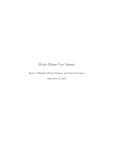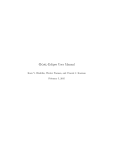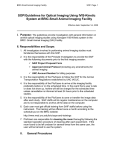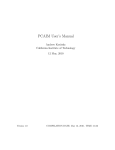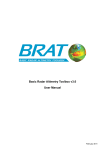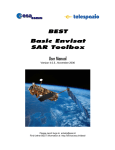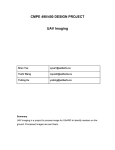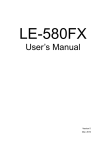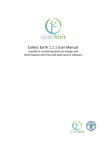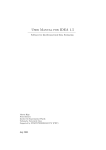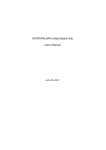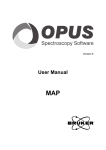Download PDF files - University of Leeds
Transcript
StaMPS/MTI Manual Version 3.3b1 Andy Hooper, David Bekaert, Karsten Spaans 12th September, 2013 School of Earth and Environment University of Leeds LS2 9JT Leeds United Kingdom Contents 1 Introduction 2 Installation 2.1 Configuration 2.2 Data display . 2.3 ROI PAC . . . 2.4 Doris . . . . . 2.5 Triangle . . . 2.6 Snaphu . . . 1 . . . . . . . . . . . . . . . . . . . . . . . . . . . . . . . . . . . . . . . . . . . . . . . . . . . . . . . . . . . . . . . . . . . . . . . . . . . . . . . . . . . . . . . . . . . . . . . . . . . . . . . . . . . . . . . . . . . . . . . . . . . . . . . . . . . . . . . . . . . . . . . . . . . . . . . . . . . . . . . . . . . . . . . . . . . . . . . . . . . . . . . . . . . . . . . . . . . . . . . . . . . . . . . . . . . . . . . . . . . . . . . . . . . . . . . . . . 3 3 3 3 4 4 4 3 Create SLCs (using ROI PAC) 5 4 Pre-processing SLCs (Level 1 product) 4.1 Reading and Cropping . . . . . . . . . . . . . . . 4.1.1 Option 1: Specify by latitude and longitude 4.1.2 Option 2: Specify by line/pixel number . . . 4.2 Oversampling SLC data (Optional) . . . . . . . . 5 Create IFGs (using DORIS) 5.1 Bulk Processing . . . . . . . . . . . . . . 5.2 Manual DEM offset correction . . . . . . 5.3 Re-running Steps . . . . . . . . . . . . . 5.4 Possible reasons for Doris SIGERV error 5.5 Disk Space . . . . . . . . . . . . . . . . . . . . . . . . . . . . . . . . . . . . . . . . . . . . . . . . . . . . . . . . . . . . . . . . . . . . . . . . . . . . . . . . . . . . . . . . . . . . . . . . . . . . . . . . . . . . . . . . . . . . . 8 8 9 9 9 . . . . . . . . . . . . . . . . . . . . . . . . . . . . . . . . . . . . . . . . . . . . . . . . . . . . . . . . . . . . . . . . . . . . . . . . . . . . . . . . . . . . . . . . . . . . . . . 11 12 14 14 15 15 . . . . . . . 16 17 17 17 18 18 19 20 6 PS Processing 6.1 Step 1: Load data . . . . . . . . . . . . . . . . . . . 6.2 Step 2: Estimate phase noise . . . . . . . . . . . . . 6.3 Step 3: PS selection . . . . . . . . . . . . . . . . . 6.4 Step 4: PS weeding . . . . . . . . . . . . . . . . . . 6.5 Step 5: Phase correction . . . . . . . . . . . . . . . 6.6 Step 6: Phase unwrapping . . . . . . . . . . . . . . 6.7 Step 7: Estimate spatially-correlated look angle error . . . . . . . . . . . . . . . . . . . . . . . . . . . . . . . . . . . . . . . . . . . . . . . . . . . . . . . . . . . . . . . . . . . . . . . . . . . . . . . . . . . . . . . . . . . . . . . . . . . . . . . . . . . . . . . . . . . . . . . 7 Small Baseline Processing 22 8 Combined MTI Processing 25 9 Plotting 26 i ii 10 Change History 10.1 Version 1.0 . . . . 10.1.1 Version 1.1 . 10.2 Version 2.0 . . . . . 10.2.1 Version 2.0.1 10.2.2 Version 2.0.2 10.2.3 Version 2.0.3 10.3 Version 2.1 . . . . . 10.4 Version 2.2 . . . . . 10.5 Version 3.0 . . . . . 10.6 Version 3.1 . . . . . 10.7 Version 3.2 . . . . . 10.8 Version 3.3 . . . . . CONTENTS . . . . . . . . . . . . . . . . . . . . . . . . . . . . . . . . . . . . . . . . . . . . . . . . . . . . . . . . . . . . . . . . . . . . . . . . . . . . . . . . . . . . . . . . . . . . . . . . . . . . . . . . . . . . . . . . . . . . . . . . . . . . . . . . . . . . . . . . . . . . . . . . . . . . . . . . . . . . . . . . . . . . . . . . . . . . . . . . . . . . . . . . . . . . . . . . . . . . . . . . . . . . . . . . . . . . . . . . . . . . . . . . . . . . . . . . . . . . . . . . . . . . . . . . . . . . . . . . . . . . . . . . . . . . . . . . . . . . . . . . . . . . . . . . . . . . . . . . . . . . . . . . . . . . . . . . . . . . . . . . . . . . . . . . . . . . . . . . . . . . . . . . . . . . . . . . . . . . . . . . . . . . . . . . . . . . . . . . . . . . . . . . . . . . . . . . . . . . . . . . . . . . . . . . . . . . . . . . . . . . . . . . . . . . . . . . 28 28 28 28 29 29 29 29 30 30 30 31 32 Chapter 1 Introduction StaMPS/MTI is made available for non-commercial applications only and can be downloaded from http://homepages.see.leeds.ac.uk/˜earahoo/stamps/ When using this software please reference Hooper et al. [2012]: Hooper A; Bekaert D; Spaans K; Arikan M (2012) Recent advances in SAR interferometry time series analysis for measuring crustal deformation, Tectonophysics, 514-517, pp.1-13. doi: 10.1016/j.tecto.2011.10.013 StaMPS (Stanford Method for Persistent Scatterers) is a software package that implements an InSAR persistent scatterer (PS) method developed to work even in terrains devoid of man-made structures and/or undergoing non-steady deformation. StaMPS/MTI (Multi-Temporal InSAR) is an extended version of StaMPS that also includes a small baseline method and a combined multi-temporal InSAR method. The original development of StaMPS was undertaken at Stanford University, but subsequent development of StaMPS and StaMPS/MTI has taken place at the University of Iceland, Delft University of Technology, and the University of Leeds. There are also contributions from users of the package based at other institutions. This manual provides a guide to running StaMPS/MTI, but does not explain all the processing. For some details on the inner workings, see Hooper [2010, 2008]; Hooper et al. [2007, 2004]; Hooper [2006]. A user group is also maintained at http://groups.google.com/group/mainsar. If you have a query, check the discussion threads there and, if not resolved, submit your question to the group. There are two pre-processing steps before getting to the PS/MTI processing proper. The first is to focus the raw data (if required), and the second is to form interferograms from single-look complex (SLC) images. ROI PAC is used for the focusing and Doris for interferogram formation. If starting with SLC images, rather than raw data, the focusing step is skipped and the images are imported directly into Doris. Currently, support is provided for processing ERS, Envisat and ALOS data, if starting with raw data, and for ERS, Envisat, RADARSAT-1/2, TerraSAR-X and COSMO-SkyMed data, if starting with SLCs. 1 2 CHAPTER 1. INTRODUCTION Both ROI PAC and Doris processing are non-standard and various shell scripts, matlab scripts and programs are included in this package to produce interferograms that are PS/MTI friendly. The PS/MTI processing itself includes C++ programs and matlab scripts to identify coherent pixels, and to extract the deformation signal for these pixels. Typing help followed by the name of the matlab script provides a brief description of the processing. Throughout this manual, commands to be entered on the command line are in blue and entries that are specific to the data set being processed and require modification are in red. The presence of >> before a command indicates that the command is a matlab script. Chapter 2 Installation Install StaMPS/MTI: tar -xvf StaMPS v3.3.tar cd StaMPS v3.3/src make make install 2.1 Configuration Edit StaMPS CONFIG.tcsh or StaMPS CONFIG.bash (depending on which shell you prefer to use) to point to the correct directories for your set-up (you will need additional programs installed, see below). source StaMPS CONFIG.xxxx This must be done whenever a new terminal is opened. You might want to add this line to your .cshrc or .bashrc file so that this is done automatically. 2.2 Data display In previous versions a program called dismph was included for displaying SLCs and interferograms, but this is no longer the case. Recommended instead is xv (http://www.trilon.com/xv) or OpenEV (http://fwtools.maptools.org/). 2.3 ROI PAC Details on installing and running ROI PAC (if needed) can be found at: http://roipac.org/ROI_PAC. 3 4 CHAPTER 2. INSTALLATION For ERS, ROI PAC requires the program getorb which must be installed in the ROI PAC/INT BIN directory and can be downloaded from: http://www.deos.tudelft.nl/ers/precorbs/tools/getorb_pack.shtml. ALOS requires the latest script of make raw alos.pl, which makes it possible to convert FBD to FBS and merge adjacent frames using the ALOS fbd2fbs and ALOS merge programs. These files can be downloaded from: http://www.roipac.org/ALOS_PALSAR ODR and arclist files containing the orbit information used by getorb can be downloaded from: http://www.deos.tudelft.nl/ers/precorbs/orbits/. These files should be stored in directories .../ODR/XXXX where XXXX is ERS1 or ERS2. For Envisat data, getorb can also be used, in which case XXXX should be Envisat. Alternatively, use the ESA DORIS (the tracking system on Envisat, not to be confused with the Doris interferometry software) orbits. Contact the ESA Help Desk (EOHelp[at]esa.int) to know where you can download these precise orbits (VOR). This is a better option at the date of writing as the ODR files have not been updated since the beginning of 2008. Envisat instrument calibration files (INS) can be downloaded from: http://earth.eo.esa.int/services/auxiliary_data/asar/current 2.4 Doris Details on installing Doris can be found at: http://doris.tudelft.nl . 2.5 Triangle The Triangle program is used for Delaunay triangulation and can be found at: http://www.cs.cmu.edu/˜quake/triangle.html. 2.6 Snaphu The optimisation routines of snaphu are used by the 3-D unwrapping code and can be downloaded from: http://www.stanford.edu/group/radar/softwareandlinks/sw/snaphu/. Chapter 3 Create SLCs (using ROI PAC) Currently support is provided for raw data from ERS, Envisat and ALOS satellites. If you are starting with SLC data rather than raw data, skip this section. Scripts have been updated to run with ROI PAC version 2.3 or 3.0. If you have the ROI PAC version 2.2 installed, you should run the versions of the SLC generation scripts with the suffix V2.2 attached. link raw data path processing path (where data path is the FULL path to your source data and processing path is the FULL path to a new processing directory you have created) This will create a directory named SLC in the processing path directory, with a subdirectory for each image named yyyymmdd. Within each subdirectory, symbolic links will be created to the data files. For ERS data the link names are IMAGERYyyymmdd and SARLEADERyyyymmdd (4 digit, not 2 digit, years), and for Envisat and ALOS data, the link names are the same as the original names. In your processing directory: mkdir SLC cd SLC mkdir yyyymmdd for each scene and within this directory create symbolic links to the raw data (and leader files if they exist). For ERS data the link names must be IMAGERYyyymmdd and SARLEADERyyyymmdd (be sure to use 4 digit, not 2 digit, years), but for Envisat and ALOS data the link names should be the same as the original names. Choose a master based on minimising perpendicular, Doppler and temporal baselines (see Hooper et al. [2007]). If you do not know the baseline data, choose a preliminary master based only on time and follow this manual as far as the make coarse step in Section 5. After running make coarse, the script master select can be used to calculate expected stack coherence. Alternatively, one can enter grep Bperp */coreg.out in the INSAR master date directory to see the perpendicular baselines with respect to the selected master (enter grep f DC con */slave.res in the SLC directory for the Doppler centroids). A new master can then be picked if necessary. If this is the case, edit master crop.in for the new master, run step master setup, then go directly to Section 5. 5 6 CHAPTER 3. CREATE SLCS (USING ROI PAC) Substitute your chosen master date in the format yyyymmdd wherever master date appears below. From the SLC directory: cd master date To use ODR orbits: step slc ers or step slc envi (use V2.2 suffix if necessary) To use DORIS orbits (Envisat only): step slc envi vor For Envisat wide-swath (DORIS orbits): step slc envi ws For ALOS data: step slc alos For ERS in Envisat type format: step slc ers envi In this case you need to update ROI-PAC with the programs provided in http://www.roipac.org/ERS Take note of the number of range looks. xv image.slc.Xlooks.ras Choose your region of interest and note the first/last azimuth lines and first/last range pixels. You should try to pick an area that is included in all the slave images too, which may not be the case if you choose an area too close to the image edge. Multiply the line numbers by the number of azimuth looks and the pixel numbers by the number of range looks to get line/pixel numbers referenced to the SLC. Information on the aspect ratio and number of looks is provided in ../looks.txt and ../ar.txt. Tip: Using XV: The displayed image is multi-looked. Select your region of interest and multiply the number of lines by the aspect ratio (ar.txt) and the number of looks (looks.txt) to get back to the original number of lines dimension. The orignal number of pixels follows by multiplying the number of pixels in the multi-looked image with the number of looks. Edit ../roi.proc and change the following: ymin = 14000 (first azimuth line minus 1000) ymax = 21000 (last azimuth line plus 1000). You will also need to uncomment this line mean pixel rng = 2900 (range pixel of middle of region of interest) step slc alos, step slc ers, step slc ers envi, step slc envi vor, step slc envi (attach V2.2 suffix if necessary), or step slc envi ws. xv image.slc.Xlooks.ras Find your region of interest again and note the new first and last azimuth line numbers (multiplying by the number of azimuth looks) . cp $MY SCR/master crop.in . 7 Edit master crop.in and update the crop area: first l and last l are the first and last azimuth line numbers, first p and last p are the first and last range pixels. step master setup cd .. (back to SLC directory) make slcs alos, make slcs ers, make slcs ers envi, make slcs envi vor, make slcs envi (attach V2.2 suffix if necessary), or make slcs envi ws. This will create SLCs for all directories listed in make slcs.list, which by default contains all data directories except the master. It may become apparent later that one or more scenes are offset from the master by so much that the focused image does not include the entire cropped master image. In which case copy roi.proc from the SLC directory to the relevant yyyymmdd directory, rename it yyyymmdd.proc and edit it so that the the part processed includes the cropped master image. Edit make slcs.list to leave only scenes that need recreating and run make slcs XXXX. Chapter 4 Pre-processing SLCs (Level 1 product) If you created SLCs with ROI PAC using raw data, skip Section: 4.1. 4.1 Reading and Cropping Currently, scripts exist for (reading and cropping single look complex (SLC) products from ERS, Envisat, RADARSAT-1/2, TerraSAR-X and COSMO-SkyMed satellites. In your processing directory, for example, under /d2/iceland volcanoes/ link slcs data path (where data path is the FULL path to your source data ) This will create a directory named SLC in the current directory, with a subdirectory for each image named yyyymmdd. Within each subdirectory, symbolic links will be created to the slc files (and leader/volume files if they exist). For ERS and RADARSAT-1 data the link names must be DAT 01.001, LEA 01.001, and VDF DAT.001. For Envisat and COSMO-SkyMed data the link name must be image.slc. For TerraSAR-X and RADARSAT-2 data, the link names must be image.slc and leader.xml. Choose a master based on minimising perpendicular, Doppler and temporal baselines (see Hooper et al. [2007]). Substitute your master date in the format yyyymmdd wherever master date appears below. cd master date step read whole XXX (where XXX is ‘ERS’, ‘Envisat’, ‘RSAT’, ‘RSAT2’, ‘TSX’, or ‘CSK’) Take note of the number of range looks. xv image.slc.Xlooks.ras 8 4.2. OVERSAMPLING SLC DATA (OPTIONAL) 4.1.1 9 Option 1: Specify by latitude and longitude edit master crop geo.in in the SLC directory, and specify your area of interest. cd master date step master read geo cd .. make read geo 4.1.2 Option 2: Specify by line/pixel number Choose area of interest and note first/last azimuth line and first/last range pixel. You should try to pick an area that is included in all the slave images too, which may not be the case if you choose an area too close to the image edge. Multiply the line numbers by the number of azimuth looks and the pixel numbers by the number of range looks to get numbers referenced to the SLC. cp $MY SCR/master crop.in . Edit master crop.in and update the crop area. first l and last l are the first and last azimuth line numbers, first p and last p are the first and last range pixels. step master read cd .. (back to SLC directory) make read This will read and crop SLCs from all directories listed in make slcs.list, which by default contains all SLC directories except the master date. 4.2 Oversampling SLC data (Optional) After focusing your RAW data or reading/cropping your SLCs, optionally, you can oversample your dataset using Doris. In your processing directory, for example, under /d2/iceland volcanoes/ cd SLC cd master date step master ovs cd .. (back to SLC directory) make ovs This will oversample SLCs from all directories listed in make slcs.list, which by default contains all SLC directories except the master date. By default, oversampling is done with a factor of 2 in both range and azimuth directions. You can change this by editing master ovs.dorisin and ovsfiles.dorisin in the SLC directory Then re-run step master ovs and make ovs to create a new oversampled dataset. 10 CHAPTER 4. PRE-PROCESSING SLCS (LEVEL 1 PRODUCT) For a single master approach, oversampling shows significant improvement in PS density especially in the rural areas (see Sousa et al. [2011] and Arıkan et al. [2010]). Chapter 5 Create IFGs (using DORIS) In the same directory where SLC and INSAR master date reside: mkdir DEM Place your DEM in this directory. cd INSAR master date If the SLCs were not created by ROI PAC create a file named dummy.slc.rsc with the following line (substituting the correct heading, to the nearest degree is fine): HEADING -167 For TerraSAR-X, the value can be found in leader.xml, and can be extracted automatically using tsx extract heading (you must have python installed to run this). If you linked SLCs using link slcs master heading is automatically extracted as image.slc.rsc and later copied to INSAR master date as master date.slc.rsc. step master orbit ODR (only run if using precise ODR orbits) edit timing.dorisin and update the following fields based on the DEM you are using: SAM SAM SAM SAM SAM SAM IN IN IN IN IN IN FORMAT DEM SIZE DELTA UL NODATA real4 /data/T156/DEM/dem data.flt 4801 4801 // rows cols 0.000833333 0.000833333 // posting in degrees 13 42 // lat and lon of upper left -9999 step master timing This step can be run alongside make orbits, make coarse and make coreg. This step was new in version 3.1, and replaces the former StaMPS codes for DEM offset correction with new code in Doris v4.0. Offsets are calculated for 30 (by default) different windows, which are printed to the screen at the end. Check that the selected offsets are consistent with the mode values of for the windows. If not, change the number of windows in timing.dorisin to a higher number, comment out the M SIMAMP process and rerun the step. If still not successful, delete the output from the timing 11 12 CHAPTER 5. CREATE IFGS (USING DORIS) step in master.res in the INSAR master date directory and ALL subdirectories, and calculate the DEM offset manually (see Section 5.2). Tip: step master timing calculates the master timing error, which is used for extracting the height from the correct position in the DEM, and geocoding. Non-precise timing information will cause geocoding to assign an inaccurate position to the pixels. The reliability of the estimated timing error mostly depends on the DEM. For example, it is not advisable to run this step if the topography of an area is flat and the DEM does not contain information about building heights. In this case, step master timing can be skipped, or you can try and calculate the DEM offset manually (see Section 5.2). You still need to edit timing.dorisin however if you intend to run make dems later. 5.1 Bulk Processing In the INSAR master date directory: make orbits This creates a subdirectory for each slave image. The default is to treat all images in the SLC directory except the master as slave images. If a different set of slave images is required, create a file named slcs.list listing the directories containing the images you wish to include, before running make orbits. Precise orbits are extracted from the ODR files if they are found (ERS and Envisat only). Tip: show porbits will let you verify the result of make orbits by indicating NUMBER OF DATAPOINTS successfully extracted the ODR files. precise orbits equal 0 indicate that no precise orbits found in the specifed ODR directory. Either check the ODR path in the doris input file in the slave directory or remove that SLC date from the slcs.list. make coarse This creates a coreg.out file in each slave subdirectory. The last 32 lines of each coreg.out file is output to the terminal at the end. Check the following values for each coreg.out file: Coarse correlation translation lines: -76 Coarse correlation translation pixels: -1 These values should be approximately the modal values from the data below them. If this is not the case and the values are wrong by more than a couple of pixels, you should edit the relevant coreg.out file and correct the values. Optionally, you can also check that the master crop is included within each slave image (only the parts of the master crop that are in ALL slaves will be considered in the later times series processing). Look for the highest and lowest values of Coarse correlation translation lines and Coarse correlation translation pixels. Add the translations to the master crop range (in master.res) and make sure the corresponding slave crop contains the translated values (in slave.res). If not, you should adjust either the master crop or the relevant slave crops. If you adjust the master crop, it is easiest to delete the whole INSAR master date directory and recreate it 5.1. BULK PROCESSING 13 with step master setup (raw data) or step master read/step master read geo (CEOS SLC data). If you adjust slave crops (by rerunning step slc XXX or step read), you need run step orbit in the slave subdirectory only for those slaves that have been adjusted. It may also be the case that there is a timing error in the orbit info and the approximate values in Start coarse orbits are too far from the real values for coarse correlation to work. In this case, estimate the coarse offsets yourself (look at the SLCs), update them in Start coarse orbits in coreg.out and rerun just the Doris COARSECORR step. make coreg (long runtime) or make coreg simple make coreg coregisters all images with baseline < 100 m directly to the master and coregisters those with larger baselines to the 3 closest slave images with a smaller baseline. These default values can be changed by copying $STAMPS/bin/make coreg to INSAR master date, editing the values at the top and running ./make coreg. make coreg simple coregisters all images directly to the master. It therefore runs quicker than make coreg but may fail in some instances for large baselines. If rerunning, make coreg does not re-coregister scenes that have already been processed. If this is required, delete the corresponding CPM Data.n1.n2 files in the coreg subdirectory, where n1 and n2 refer to the order of the two coregistered scenes in make coreg.list (0 for the master), or delete the entire coreg subdirectory to re-coregister all scenes. Also by default, all cross-correlations with coherence greater than 0.3 are selected initially by Doris. If there is generally good coherence, this value can be increased (by editing coreg.dorisin in the INSAR master date directory) to make run times faster or, if coherence is particularly bad, the value can be decreased, though any cross-correlation with coherence below 0.12 is usually never correct. When make coreg has finished, check the size of the CPM Data files in the coreg directory (ls -l CPM Data*). View any which are around 1000 bytes or less, and if there are 12 lines or less, delete the file, as the coregistration for this pair has failed. After deletion, the inversion step must be rerun by entering update coreg within the INSAR master date/coreg directory. Note that if all CPM Data files associated with a particular slave are deleted, then there is a problem with that slave image, e.g. it is badly focused. Resolve the problem, then rerun make coreg to recreate the CPM Data files for this slave. make dems (long runtime - can run alongside make coreg). If the area being processed has insignificant topography, this step can be skipped. make resample After running, check the sizes of the resampled SLC images (ls -l */*.slc). They should be all identical. For any that differ, the slave crop does not include the entire master crop, probably due to a problem with coregistration for that slave. After resolving the problem(s), run step resample in the slave subdirectory for the problem slaves only. make ifgs or make ifgs nodem (run the latter if you skipped make dems) xv */*dem Xl.ras (X is number of range looks) and check that each interferogram looks OK (i.e., 14 CHAPTER 5. CREATE IFGS (USING DORIS) the amplitude looks reasonable and there is at least a little coherence apparent in the phase) Geocoded coordinates are needed in subsequent PS processing. To calculate the latitude and longitude of each pixel, run the next command in only one of the slave directories. step geo 5.2 Manual DEM offset correction This step need only be run if step master timing failed. It should be run after make coarse and before make dems. Choose a slave close in time and space. In the yyyymmdd subdirectory for the chosen slave: step step step step coreg dem (can be run alongside step coreg) resample ifg matlab -nojvm -nosplash >>calc dem offset This estimates the offset of the DEM range slope from the interferogram amplitude and displays the best-fitting result (DEM slope in blue, amplitude in red). Check that the offset is reasonable by zooming in on a few places. If not use >>plot amp dem(dem down,dem right) to adjust the offsets in azimuth and range until a better fit is achieved. You can adjust red contrast and blue brightness (default 0.5 and 1) to vary contrast between amplitude image and DEM (see >>help plot amp dem) Once happy with the fit, update the values for M RG T ERROR and M AZ T ERROR in dem.dorisin and geocode.dorisin (in the INSAR master date directory), by adding the values output by calc dem offset or plot amp dem. 5.3 Re-running Steps make orbits processes all images listed in slcs.list. Delete slcs.list to process all slave SLC images in the main SLC directory. make coarse processes all slave subdirectories in make ifgs.list. Delete make ifgs.list to process all subdirectories containing a slave.res file. make dems, make resample and make ifgs process all slave directories in make ifgs.list. Delete make ifgs.list to process all directories containing a coreg.out file. make coreg processes all slave subdirectories listed in make coreg.list (in the coreg subdirectory), which is initially a copy from make ifgs.list. Extra images can be added to the bottom 5.4. POSSIBLE REASONS FOR DORIS SIGERV ERROR 15 of this file, but no lines should ever be deleted, as n1 and n2 in the CPM Data.n1.n2 files refer to the order of the files listed in make coreg.list. The following individual steps can be rerun in the individual yyyymmdd subdirectories of INSAR master date: step orbit extracts orbit info. step coarse coregisters coarsely. step coreg coregisters the slave image directly to the master (may be different to results from make coreg which includes slave-slave coregistration). step resample resamples the slave image. step dem creates the simulated dem interferogram. step ifg creates the final interferogram. 5.4 Possible reasons for Doris SIGERV error • master.res or slave.res (as specified in the .dorisin file being run) is missing • orbits are missing from master.res or slave.res • higher order coefficients in coregpm are too large - makes resampling impossible • slave SLC doesn’t overlap the master cropped SLC. 5.5 Disk Space Many intermediate files are produced and disk space requirements are therefore large (approximately 12.5 GB per image, if the whole image area is processed). Once step 1 of stamps matlab script has been run, the following may be run in INSAR master date to free up space (only easily recreatable files are deleted): make clean ifgs To recreate the files deleted by this script, run make ifgs in the INSAR master date directory. make clean resample To recreate the files deleted by this script, run make resample in the INSAR master date directory. make clean raw (if you created SLCs using ROI PAC). To recreate files deleted by this script, run make slcs XXXX in the SLC directory. Chapter 6 PS Processing First, create single master interferograms by following Chapter 5. In the INSAR master date directory run mt prep 0.4 3 2 50 200 where 0.4 3 2 50 200 = = = = = amplitude dispersion (0.4-0.42 are reasonable values) number of patches in range (default 1) number of patches in azimuth, (default 1) overlapping pixels between patches in range (default 50) overlapping pixels between patches in azimuth (default 200) The number of patches you choose will depend on the size of your area and the memory on your computer. Generally, patches containing < 5 million SLC pixels are OK. The parameters that control the processing are set to default values which you can view with: matlab >>getparm You can modify any parameters from the default using >>setparm(‘param name’,param value) Only enough characters of param name to make it unique are required. Setting param value to nan resets the parameter to the default value. >>stamps The default is to run all steps. A subset of steps can also be selected, see >>help stamps for details. Steps 1 to 5 run by default on individual patches after which the patches are merged into one. Steps 6 to 8 run by default on the merged patch. It is also possible (though not recommended) to run steps 6 to 8 on individual patches by setting the patch flag to ‘y’, e.g., >>stamps(6,8,‘y’) Once Step 1 has been run you can run >>ps info to list brief information for each of the interferograms included. 16 17 6.1. STEP 1: LOAD DATA 6.1 Step 1: Load data Converts the data into the formats required for PS processing and stores them in matlab workspaces. 6.2 Step 2: Estimate phase noise This is an iterative step that estimates the phase noise value for each candidate pixel in every interferogram. Processing is controlled by the following parameters: Parameter Name max topo err Default 5 filter grid size 50 filter weighting ‘P-square’ clap win 32 clap low pass wavelength 800 clap alpha 1 clap beta gamma change convergence 0.3 0.005 Description Maximum uncorrelated DEM error (in m). Pixels with uncorrelated DEM error greater than this will not be picked (this includes error due to the phase center of the resolution element being offset from the middle of the pixel in range). Setting this higher, however, increases the mean γ value (coherence-like measure, see Hooper et al. [2007]) of pixels that have random phase. Pixel size of grid (in m). Candidate pixels are resampled to a grid with this spacing before filtering to determine the spatiallycorrelated phase. Weighting scheme (PS probability squared), the other possibility being ‘SNR’. Candidate pixels are weighted during resampling according to this scheme. CLAP (Combined Low-pass and Adaptive Phase) filter window size [Hooper et al., 2007]. Together with filter grid size, determines the area included in the spatially-correlated phase estimation. CLAP filter low-pass contribution cut-off spatial wavelength (in m). Wavelengths longer than this are passed. CLAP α term. Together with the β term, determines the relative contribution of the low-pass and adaptive phase elements to the CLAP filter. CLAP β term Threshold for change in change in mean value of γ (coherencelike measure). Determines when convergence is reached and iteration ceases. 6.3 Step 3: PS selection Pixels are selected on the basis of their noise characteristics. This step also estimates the percentage of random (non-PS) pixels in a scene from which the density per km2 can be obtained. Processing is controlled by the following parameters: 18 CHAPTER 6. PS PROCESSING Parameter Name Default select method density rand ‘DENSITY’ 20 percent rand 20 drop ifg index [] Description Other option ‘PERCENT’. Maximum acceptable spatial density (per km2 ) of selected pixels with random phase. Only applies if select method is set to ‘DENSITY’. At this stage we can usually accept a high density, as most random-phase pixels will be dropped in the next step. Maximum acceptable percentage of selected pixels with random phase. Only applies if select method is set to ‘PERCENT’ Interferograms listed here (by order number given in >>ps info) will not be included in the selection calculations. 6.4 Step 4: PS weeding Pixels selected in the previous step are weeded, dropping those that are due to signal contribution from neighbouring ground resolution elements and those deemed too noisy. Data for the selected pixels are stored in new workspaces. Processing is controlled by the following parameters: Parameter Name Default weed standard dev 1.0 weed max noise Inf weed time win 730 drop ifg index [] Description Threshold standard deviation. For each pixel, the phase noise standard deviation for all pixel pairs including the pixel is calculated, If the minimum standard deviation is greater than the threshold, the pixel is dropped. If set to 10, no noise-based weeding is performed Threshold for the maximum noise allowed for a pixel. For each pixel the minimum pixel-pair noise is estimated per interferogram. Pixels whose maximum interferogram noise value is higher than the indicated threshold are dropped. Smoothing window (in days) for estimating phase noise distribution for each pair of neighbouring pixels. The time series phase for each pair is smoothed using a Gaussian-weighted piecewise linear fit. weed time win specifies the standard deviation of the Gaussian. The original phase minus the smoothed phase is assumed to be noise. Interferograms listed here (by order number given in >>ps info) will not be included in the weeding calculations. 6.5 Step 5: Phase correction The wrapped phase of the selected pixels is corrected for spatially-uncorrelated look angle (DEM) error. At the end of this step the patches are merged. Processing is controlled by the following parameters: 19 6.6. STEP 6: PHASE UNWRAPPING Parameter Name merge resample size Default 0 merge standard dev inf Description Coarser posting (in m) to resample to. If set to 0, no resampling is applied. Threshold standard deviation. For each resampled pixel, the phase noise standard deviation is computed. If the standard deviation is greater than the threshold, the resampled pixel is dropped. Only applied in case of resampling. If your merged results contain so many PS pixels that your computer has memory issues, consider setting merge resample size to a higher number, which will result in coarser sampling. Check the wrapped phase of the selected pixels after running this step, e.g., >>ps plot(‘w’) In terms of reprocessing, the first parameter to play with is weed standard dev. If it looks like too many noisy pixels are being chosen, the value can be reduced. If very few pixels are chosen, the value can be increased. If still too few pixels are being selected such that any signal is generally undersampled, variation of Step 3 parameters can be tried. The number of initial candidates can also be increased by setting the amplitude dispersion higher in mt prep. 6.6 Step 6: Phase unwrapping Processing is controlled by the following parameters: Parameter Name Default unwrap method unwrap prefilter flag ‘3D’ ‘y’ unwrap patch phase ‘n’ unwrap grid size 200 unwrap gold n win unwrap time win 32 730 unwrap gold alpha drop ifg index 0.8 [] Description Unwrapping method. Prefilter phase before unwrapping to reduce noise. Other option (not generally recommended) ‘n’. Use the patch phase from Step 3 as prefiltered phase. If set to ‘n’ (recommended), PS phase is filtered using a Goldstein adaptive phase filter. Resampling grid spacing. If unwrap prefilter flag is set to ‘y’, phase is resampled to a grid with this spacing. Window size for Goldstein filter. Smoothing window (in days) for estimating phase noise distribution for each pair of neighbouring pixels. The time series phase for each pair is smoothed using a Gaussian window with standard deviation of this size. Original phase minus smoothed phase is assumed to be noise, which is used for determining probability of a phase jump between the pair in each interferogram. Value of α for Goldstein filter. Interferograms listed here (by order number given in >>ps info) will not be unwrapped. Note that if re-running Step 6 and Step 7 has been run, estimates of SCLA and master atmosphere and orbit error (AOE) will be subtracted before unwrapping. If you do not wish this to occur, reset these estimates before running Step 6 with >>scla reset (This subtraction of SCLA and master AOE has not however been implemented with the unwrap prefilter flag = ‘n’ option.) 20 CHAPTER 6. PS PROCESSING After running step 6, display the output with >>ps plot(‘u’) Check for unwrapping errors i.e., phase jumps in space which are uncorrelated in time. Pay attention to the color scale. It may help to set it to a narrower range, e.g., [−2π, 2π] (see plotting options in chapter 9). Unwrapping errors are more likely to occur in longer perpendicular baseline interferograms. This is for two reasons, firstly there is more noise associated with each PS pixel, and secondly, the phase due to any spatially-correlated look angle (SCLA) error is larger, as it is proportional to perpendicular baseline. Noise is reduced by spatial filtering before unwrapping, but it is also possible to reduce the SCLA error phase by estimating the SCLA error from the interferograms that have been unwrapped OK by running Step 7. If Step 6 is re-run after Step 7 has been run, the SCLA error phase is temporarily subtracted from the wrapped phase before unwrapping. The unwrapping accuracy is further improved by also temporarily subtracting the atmosphere and orbit error (AOE) phase of the master image, present in all the interferograms, which is also estimated in Step 7. 6.7 Step 7: Estimate spatially-correlated look angle error Spatially-uncorrelated look angle (SULA) error was calculated in Step 3 and removed in Step 5. In Step 7, spatially-correlated look angle (SCLA) error is calculated which is due almost exclusively to spatially-correlated DEM error (this includes error in the DEM itself, and incorrect mapping of the DEM into radar co-ordinates). Master atmosphere and orbit error (AOE) phase is estimated simultaneously. Processing is controlled by the following parameters: Parameter Name scla drop index Default scla deramp drop ifg index ‘n’ [] [] Description Interferograms listed here (by order number given in >>ps info) will not be included in the SCLA calculations, but will still be included in Step 6 and previous steps. If set to ‘y’, a phase ramp is estimated for each interferogram. Interferograms listed here (by order number given in >>ps info) will not be included in the SCLA calculations, nor will they be included in Step 6 and previous steps. Display the estimate of SCLA error with >>ps plot(‘d’) Units are phase per m of perpendicular baseline, with 0.01 radians/m corresponding to about 12 m of DEM error for the Envisat I2 swath. You can use >>K2q to do the conversion for ERS, Envisat I2 swath or ALOS. Display the estimate of master atmosphere and orbit error (AOE) phase with >>ps plot(‘m’) Display the phase ramps (if scla deramp is set to ‘y’) with >>ps plot(‘o’) Unwrapped phase minus one of, or a combination of the above can be plotted with ‘u-d’, ‘u-m’, ‘u-o’, ‘u-dm’, ‘u-do’, or ‘u-dmo’. 6.7. STEP 7: ESTIMATE SPATIALLY-CORRELATED LOOK ANGLE ERROR 21 After running Step 7, check that the estimates seem reasonable, i.e., >>ps plot(‘u-dm’) looks generally smoother than >>ps plot(‘u’) (note that the default colour scales will be different). If not generally smoother, one or more interferograms have probably been incorrectly unwrapped (usually those with large perpendicular baselines). Identify those that appear incorrectly unwrapped, add them to scla drop index and rerun Step 7, e.g., to drop the 13th and 14th interferograms, >>setparm(‘scla d’,[13:14]) >>stamps(7,7) A list of interferograms with baselines greater than, for instance, 400 m can be retrieved with >>[bperp,index]=ps baselines(400) If you want to assess any change in your results after reruning Step 7, you can save your figures, e.g., >>ps-plot(‘d’,-1) will save as a .mat file the results of calculating the option ‘d’. Once happy that all included interferograms are generally smoother, rerun Step 6. Step 6 will subtract the estimates of SCLA and master AOE before unwrapping (as long as unwrap prefilter flag = ‘y’), and add them back in afterwards . If more interferograms become reliably unwrapped on rerunning, remove them from scla drop index before re-running Step 7. This can be repeated until all interferograms are reliably unwrapped, or until no further improvement is seen. If there is non-steady deformation present in some interferograms and, by chance, it correlates with perpendicular baseline, it can get mapped into the SCLA error. This may be evidenced as propagation of any deformation in ps plot(‘u-dm’)to all interferograms (though the sign for each will depend on the perpendicular baseline sign), or correlation of ps plot(‘d’) with ps plot(‘m’). If you suspect this is occurring, you can attempt to remove the deformation/baseline correlation by adding or subtracting interferograms to scla drop index. Note that time and baseline info can be displayed with >>ps info If some interferograms are still not reliably unwrapped, try increasing unwrap grid size to 200 m or more. This will reduce the effects of noise by smoothing more, but do not set it higher than the distance over which you expect deformation phase to vary by about π/2. Another thing to try is dropping noisier pixels by setting weed standard dev to a lower value, and re-running from Step 4, or increasing merge resample size (and/or reducing merge standard dev) and rerunning from Step 5. Chapter 7 Small Baseline Processing First, create single master interferograms by following Chapter 5. If PS processing has not been run, in the INSAR master date directory load baseline info into matlab workspaces with: mt extract info matlab >>ps load info To determine which small baseline interferograms to make, in the INSAR master date directory run: matlab >>sb find (rho min , Ddiff max , Bdiff max) Adjust the input parameters according to your data set, where rho min is the minimum coherence based on the maximum temporal Ddiff max and perpendicular Bdiff max decorrelated baselines. There should be no isolated clusters of images. More connections can be made by reducing rho min, or individual connections can be added by editing small baselines.list, which is created by sb find. The connections in small baselines.list can then be plotted with: >>plot sb baselines. To create the small baseline interferograms listed in small baselines.list in the INSAR master date directory, run: make small baselines. If the Doppler centroid is high, Doris may fail when filtering in azimuth. You can skip azimuth filtering with make small baselines 1 Range filtering may also be skipped with make small baselines 1 1 The script make small baselines will create a new subdirectory called SMALL BASELINES within the INSAR master date directory, containing a subdirectory for each small baseline interferogram. Within the SMALL BASELINES directory run mt prep 0.6 3 2 50 200 where 22 23 0.6 3 2 50 = = = = 200 = amplitude difference dispersion (0.6 is reasonable) number of patches in range (default 1) number of patches in azimuth, (default 1) overlapping pixels between patches in range (default 50) overlapping pixels between patches in azimuth (default 200) Note that the first parameter is amplitude difference dispersion rather than amplitude dispersion as used for PS processing, and a higher value should be given, e.g., 0.6. As for PS processing, small baseline MTI processing is controlled by various parameters that can be modified with >>setparm and processing is initiated with matlab >>stamps When running this process, the amount of the computer load is probably much higher than during PS processing. This may cause the program to stop due PC memory limitations. If this is the case, the number of patches should be increased, then rerun mt prep. In general patch sizes smaller < 4 million SLC pixels are OK. For small baselines processing, some of the parameters have different default values compared to PS processing: Parameter Name Default select method density rand ‘DENSITY’ 2 percent rand 1 weed standard dev inf unwrap method merge resample size ‘3D QUICK’ 100 Description Other option ‘PERCENT’. Maximum acceptable spatial density (per km2 ) of selected pixels with random phase. Only applies if select method is set to ‘DENSITY’. Maximum acceptable percentage of selected pixels with random phase. Only applies if select method is set to ‘PERCENT’ Threshold standard deviation. For each pixel, the phase noise standard deviation for all pixel pairs including the pixel is calculated, If the minimum standard deviation is greater than the threshold, the pixel is dropped. If set to 10, no noise-based weeding is performed Unwrapping method. Coarser posting (in m) to resample to. If set to 0, no resampling is applied. Step 6 includes extra processing after phase-unwrapping to retrieve the phase with respect to the original master by least-squares inversion. Step 7 includes extra processing to calculate the SCLA error from both small baseline and single master interferograms. Step 7 is controlled by the following parameters: 24 CHAPTER 7. SMALL BASELINE PROCESSING Parameter Name Default sb scla drop index [] scla drop index [] scla deramp drop ifg index ‘n’ [] Description SB Interferograms listed here (by order number given in >>sb info) will not be included in the SCLA calculations, but will still be included in Step 6 and previous steps. Interferograms listed here (by order number given in >>ps info) will not be included in the single master SCLA calculations. If set to ‘y’, a phase ramp is estimated for each interferogram. SB Interferograms listed here (by order number given in >>ps info) will not be included in the SCLA calculations, nor will they be included in Step 6 and previous steps. As for PS processing, repeating Step 6 after running Step 7 may improve phase-unwrapping accuracy. Accuracy can also potentially be improved by setting unwrap method to ‘3D’ (default is ‘3D QUICK’ for small baseline processing) before running Step 6, although this will take longer to run. Unwrapped phase of small baseline interferograms can be viewed using ps plot with the ‘usb’ options. SCLA error estimated from SB inteferograms can be plotted using the ‘d’ option (the ’D’ option will give SCLA error estimated from single master interferograms). Residuals between the unwrapped phase of the small baseline interferograms and that predicted from the model values for the single master phase can be plotted with the ‘rsb’ option. The residuals for each small baseline interferogram should be visually inspected, together with the wrapped and unwrapped phase for each (N.B., you will probably want to view only a few at a time using the IFG LIST option of ps plot) . Isolated residuals less than π in magnitude are OK, but spatially-correlated residuals indicate an unwrapping problem in one or more interferograms. When this is the case, identify which interferogram(s) are incorrectly unwrapped (N.B., one badly unwrapped interferogram can cause non-zero residuals for many interferograms) and drop them from the unwrapping process, by setting drop ifg index and rerunning Step 6. You can view a baseline plot for all interferograms not dropped with plot sb baselines. Once there are no more spatially-correlated residuals, check the unwrapped phase of each of the interferograms with ps plot(‘usb-d’). If there is non-steady deformation present in some interferograms and, by chance, it correlates with perpendicular baseline, it can get mapped into the SCLA error. This may be evidenced as propagation of any deformation in ps plot(‘usb-d’)to all interferograms (though the sign for each will depend on the perpendicular baseline sign). If you suspect this is occurring, you can attempt to remove the deformation/baseline correlation by adding or subtracting interferograms to sb scla drop index. Note that time and baseline info can be displayed with >>sb info. If you are interested in the time series (not just mean velocities) you should also check the unwrapped phase of each of the single master interferograms with ps plot(‘u-dm’). If there is non-steady deformation present in some interferograms and, by chance, it correlates with perpendicular baseline, it can also get mapped into the SCLA error. This may be evidenced as propagation of any deformation in ps plot(‘u-dm’)to all interferograms (though the sign for each will depend on the perpendicular baseline sign), or correlation of ps plot(‘D’) with ps plot(‘m’). If you suspect this is occurring, you can attempt to remove the deformation/baseline correlation by adding or subtracting interferograms to scla drop index. Note that time and baseline info can be displayed with >>ps info. Chapter 8 Combined MTI Processing Pixels selected by both PS and small baseline methods can be combined after Step 5 has completed for both methods. Data can be combined either for the whole area or for an individual patch, depending on whether you are in the INSAR master date directory or one of the PATCH X subdirectories. Run >>ps sb merge This will create a new subdirectory MERGED in the INSAR master date directory, and a PATCH X subdirectory within this, if you are merging only an individual patch. For Step 6 onwards, processing is the same as for small baseline processing 25 Chapter 9 Plotting Overview scripts The following matlab scripts can be used to plot the data in various ways (use >>help in matlab to see all options): Matlab command >>plot all ifgs Description Plots all multilooked interferograms >>ps plot Plots values for each selected pixel, on various backgrounds, for chosen interferograms >>ps plot ifg Plots a value for each selected pixel, on various backgrounds Options value type, background, phase limits, reference ifg, ifg list, nx , colorbar flag, textsize, textcolor, longitude and latitude range, individual pixel selection phase, background, color map limits, longitude and latitude range To change the size of the square representing each selected SLC pixel (default 120 m) change the plot scatterer size parameter, e.g., >>setparm(‘plot s’,200) The resolution of the background (for bg flag of 0 or 1) is set by default to be 3 times finer than plot scatterer size. You can change this by updating plot pixels scatterer. The resolution for plots on the DEM is controlled by plot dem posting. You can select a reference area by setting parameters ref lon and ref lat (for a rectangular area) or ref centre lonlat and ref radius (for a circular area). All plots will then be referenced to the mean value for this area. If not set, the reference value is the mean value for the whole area. Normal phase sign conventions apply: if the master predates the slave, positive phase implies movement away from the satellite. For plotting of velocities, the units are mm/year with positive values being towards the satellite (in 26 27 versions prior to v3.1, the sign convention for velocity was the opposite). Data is output to ascii files with >>ps output plot v.gmt can then be run to plot mean LOS velocities on the DEM in shaded relief, using GMT. Copy (from $STAMPS/bin) and edit the script to adjust plotting parameters. Time series plots >>ps plot(‘v-d’,1,0,0,[1:3,7:8],‘ts’) plots the mean LOS velocity, calculated from single master interferograms for PS processing, or small baseline interferograms for SB and combined processing. The ‘ts’ switch enables the user to select individual points for generating time series (TS) plots. Initially, mouse input is activated to select a point on the velocity plot which is defined by ‘v-d’ switch. Later, using the ‘new TS plot’ button, you can define additional new points for the TS plot. You can change ‘radius factor’ in the white text box to search in a larger radius, unless you can’t find points with the default factor (search radius = radius factor * radius, where radius is 1 arcsecond by default). Another example: ps plot(’v-d’,1,0,0,[], 0, 0, 0,[], [28.6 28.9], [41.2 41.27],’ts’) plots velocities for the subset defined by longitude and latitude, and generates TS plots, the rest of the switches are set to default values. Tip: The position of ‘ts’ switch could be anywhere after plot option ‘v-d‘. For details type ps plot without any arguments on the matlab prompt to get help. Using the ‘V-D’ option (rather than ‘v-d’) forces the use of single master interferograms for the estimation, even for SB or combined processing Google earth KML file >>ps gescatter(‘project velo.kml’,ph disp,10,0.4), using gescatter.m will generates a kml file from ph disp matrix for every 10 points with an opacity of 0.4. Later, you can load the ‘project velo.kml’ file to google earth for visualisation. Tip: Use >>ps plot(‘v-d’,-1) to save PS velocity estimation to a mat file and later retrieve with >>load ps plot v-d ph disp command and use as an input to ps gescatter. Chapter 10 Change History N.B. This list is not comprehensive. 10.1 Version 1.0 • Initial beta release. 10.1.1 Version 1.1 • Addition of make resample and make filtazi resample to give the option of filtering in azimuth. As this involves updating master.res differently for every image pair, a separate master.res is now maintained in each individual slave directory. • Update to make coreg to be more efficient (uses a different strategy for picking which images to coregister). • Addition of step coreg to allow coregistration for an individual slave image with the master image. • Update to make amp dem.m to display the image in matlab instead of using disrg • Error in ps load initial.m fixed so that individual PS bperp and look angle values are now correct. • Addition of ps load dem.m to allow plotting of PS on shaded relief topography. • Other tidying of code. 10.2 Version 2.0 • Processing added to enable input of CEOS Level 1 SLC data. 28 10.3. VERSION 2.1 29 • step master setup added. • Extra step added to ps weed.m to drop pixels that are not correlated in time with surrounding pixels. • Ability to process data in smaller patches added. • Changes to way data saved, for efficiency. • Changes to ps est gamma quick.m to make it restartable and to make convergence criteria more reliable. • New statistical cost function 3-D unwrapping algorithm. • Look angle bug fixed. 10.2.1 Version 2.0.1 • Some bug fixes. 10.2.2 Version 2.0.2 • Flattening/DEM processing changed back to that in Version 1.1 (to remove a bug that was introduced). 10.2.3 Version 2.0.3 • Changes for compatibility with 64-bit machines. • New scripts for working with Envisat level 1 SLCs. • Change to ps weed.m to handle duplicate lat/lon assignment by Doris. 10.3 Version 2.1 • Estimation of spatially-correlated look angle (DEM) error and master atmosphere and orbit error added (step 7). • Phase-unwrapping (step 6) now uses estimates from step 7 if present. • Merging of patches made into an explicit step (step 8). This change was reversed in Version 2.2. • Estimation of spatially-correlated noise moved to step 9. This change was reversed in Version 2.2. • ps info added 30 CHAPTER 10. CHANGE HISTORY 10.4 Version 2.2 • Updated for ROI PAC version 3.0 compatibility. • Crop definition simplified in SLC creation. • Extra integrity checks added. • Manual updated with more instructions on error checking during interferogram production. • make orbits split into make orbits and make coarse, with corresponding step orbit and step coarse scripts added. • Automatic DEM offset estimation added. • Optional weeding of pixels with zero elevation added. • Merging of patches now done after step 5 (implicitly). • Unwrapping now uses snaphu optimisation routines to search for the minimum cost solution (costs still estimated by StaMPS). • Merge of mean amplitude image added allowing ps plot to plot on amplitude background for merged patches. 10.5 Version 3.0 • Small baseline and combined combined time series methods added. 10.6 Version 3.1 • Compatibility with Doris v4.0 added. • Support for ERS and RADARSAT-1 SLCs, and ALOS raw data added. • Option to estimate phase ramps added. • Isolated images allowed in small baseline processing. • Simultaneous estimation of mean velocity added to SCLA estimation. • SCLA smoothed before subtraction for unwrapping purposes. • Selection criteria for small baseline interferograms amended to be coherence based. • Option added to ps plot.m to plot incremental phase change for each date. • Option added to ps plot.m to plot mean velocity standard deviations. • Sign convention for plotting mean velocities flipped. • ps baselines.m added. 31 10.7. VERSION 3.2 10.7 Version 3.2 • Support for TerraSAR-X SLCs added. • New option (and new default for small baselines) to resample to coarser sampling during merging of patches (using parameter merge resample size and optionally merge standard dev). This greatly reduces memory needs and processing time for Steps 6 onwards. • New option (and the new default) to select pixels based on spatial density of random phase pixels, rather than percentage (relevant parameters: select method and density rand). This ensures even sampling over all patches. • Weighting added to the inversion for single master phase from small baseline phase, using the variance-covariance of the wrapped phase. • Precise orbit processing corrected for ERS SLCs. • Plotting on amplitude improved. • Magnitude raster files created automatically during read steps. • Timing estimation more robust and easily re-runnable. • Option added to make small baselines to skip range filtering (to skip azimuth filtering was already an option). • Memory needs reduced during merging of patches, and combining of amplitude and dem. • Program display no longer compiled by default. • Parameter added to control (unwrap gold alpha). amount of Goldstein filtering during unwrapping • Code to use translation lines between slave and master in slave-slave coregistration added back. • Bug fixed that deletes timing info from master during resample. • Bug fixed that drops master from calibration. • Bug fixed that outputs warnings for missing process control flags. • Plotted value type is displayed in figure name. • Plotting time series on a user mouse input. • Generating Google Earth kml file from velocity estimates. • Scripts included to generate oversampled data within StaMPS processing chain. • unwrap ifg index replaced by drop ifg index and its use extended to steps 2 to 4. • recalc index and sb recalc index sb scla drop index. replaced by scla drop index and 32 CHAPTER 10. CHANGE HISTORY • Logging added • Option to set circular reference area added using ref centre lonlat and ref radius. • Merging of amplitude files moved to ps load mean amp.m from ps merge patches.m • Change plot sb baselines to work also in small baseline/merged directories and plot only interferograms that are not dropped. • Plots on DEM changed to include only the necessary part of the DEM. • Plotting resolution changed to be controlled by plot scatter size and plot pixels scatterer. Shape of pixels changed to be always square (instead of rectangular). • Option added to run without a DEM (in the case where topography is not significant). • Linking scripts: link raw and link slcs to generate SLC directory structure for pre-processing. • Option added to coregister all slaves directly to the master. 10.8 Version 3.3 • Update the manual with extra tips and current websites. • Expand the manual on small baselines. • Batch processing by specifiying processing list in interferogram shell scripts. • SLC compatibility for RADARSAT-2 and COSMO-SkyMed. • Raw data Envisat WS capability • Matlab 2011/2012 compatibility • Fix bug in ps info • Improved unwrapping and new unwrapping options. • Improved processing efficiency. Bibliography Arıkan, M., A. Hooper, and R. Hanssen, Radar time series analysis over west anatolia, European Space Agency, (Special Publication) ESA SP-677 , 2010. Hooper, A., A multi-temporal InSAR method incorporating both persistent scatterer and small baseline approaches, Geophys. Res. Lett., 35, L16,302, 2008. Hooper, A., A statistical-cost approach to unwrapping the phase of InSAR time series, European Space Agency, (Special Publication) ESA SP-677 , 2010. Hooper, A., H. Zebker, P. Segall, and B. Kampes, A new method for measuring deformation on volcanoes and other natural terrains using InSAR persistent scatterers, Geophys. Res. Lett., 31, 2004. Hooper, A., P. Segall, and H. Zebker, Persistent scatterer InSAR for crustal deformation analysis, with application to Volcán Alcedo, Galápagos, J. Geophys. Res., 112, 2007. Hooper, A., D. Bekaert, K. Spaans, and M. Arikan, Recent advances in sar interferometry time series analysis for measuring crustal deformation, Tectonophysics, 514 - 517 , 1 – 13, 2012. Hooper, A. J., Persistent scatterer radar interferometry for crustal deformation studies and modeling of volcanic deformation, Ph.D. thesis, Stanford University, 2006. Sousa, J. J., A. Hooper, R. Hanssen, L. Bastos, and A. Ruiz, Persistent scatterer insar: A comparison of methodologies based on a model of temporal deformation vs. spatial correlation selection criteria, Remote Sensing of Environment, 115, 2652–2663, 2011. Links to PDF files for the references above can be found at: http://www.see.leeds.ac.uk/people/a.hooper 33




































